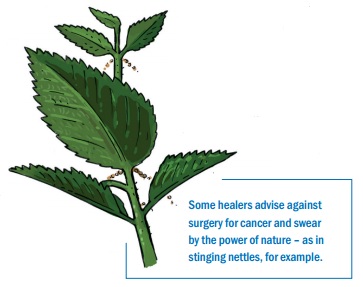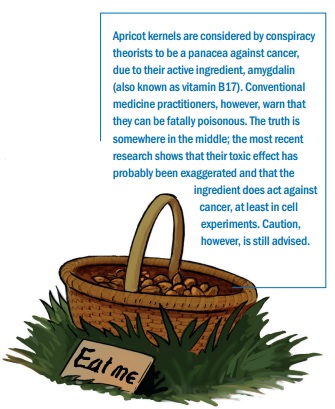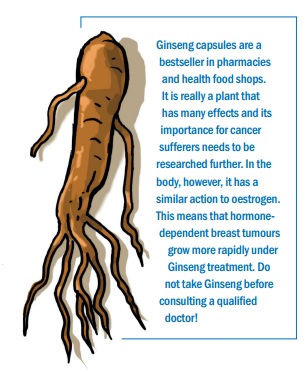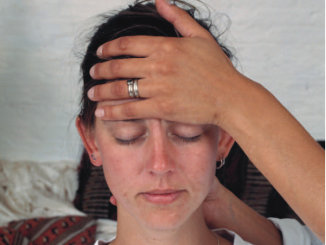
Its not uncommon for people diagnosed with cancer to explore how alternative practitioners might help. Some can, or at least do no harm. But the chances of running into a charlatan whose advice could be fatal are shockingly high, as this undercover investigation, first published in the German magazine Stern, demonstrates.
The spirit healer had inherited her ‘gift’ from her father. She now wants to use it to help us make a potentially life-or-death decision: whether or not to have surgery for breast cancer. We have travelled more than 1000 kilometres from Hamburg to this Swiss village, with a population of around 3000, for advice. The practice, on the first floor of a 1960’s house, has a sombre feel − grey carpeting, black leather chairs in the waiting room, and certificates on the walls.
She had described over the phone how she makes her diagnoses: “I place my hands on the chest and absorb the tumour’s energy. I then sense its activity, whether it is spreading rapidly or slowly.” Today, she faces a different challenge. Katja, acting as my wife, does not really have breast cancer. Her diagnostic records − a mammogram and a histologic examination − have been taken from another patient.
The Swiss healer is the last on our list. We’ve been to 19 other practitioners of alternative medicine before her, and have now reached the end of a three-week journey through the world of miracle healers. We have consulted 10 naturopaths and 10 doctors practising alternative medicine.
I had selected the healers in consultation with two academics, both authors of textbooks on alternative medicine, and familiar with the scene: Jutta Hübner, from the German Cancer Society, and Karsten Münstedt, consultant oncologist at the University Hospital of Giessen. All our healers claim to specialise in cancer care. We found them on Google, using the sort of search terms that might occur to a distressed woman when first diagnosed with breast cancer, such as “alternative treatments for breast cancer” or “alternative medicine for cancer”. Seventeen German doctors and German-registered naturopaths came up with the most hits on Google, and a further three were recommended by one or other of them, including the Swiss spirit healer, who “deliberately” didn’t have her own website.
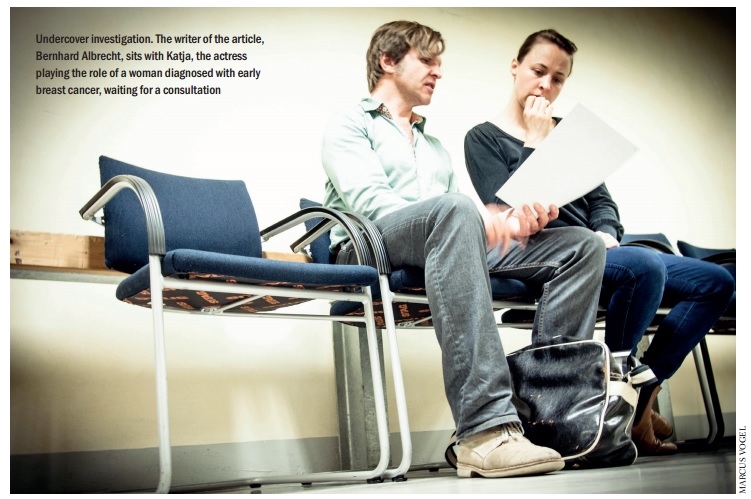
One in four Germans believe in the powers of miracle and spirit healers, and a good 40% believe in astrology. Cancer patients are vulnerable to unsubstantiated promises of a cure, as indicated by the Amazon bestseller list. Of the 20 bestsellers in the category ‘cancer’, the vast majority centre on conspiracy theories or promote cancer diets as cures.
I share many of the misgivings about cancer treatment in clinical practice; in particular, the increasing number of very expensive therapies of questionable value being put on the market by pharmaceutical companies. Moreover, doctors do often fail to fully appreciate the level of patients’ anxiety, and they can get things wrong. Yet there’s no denying the great progress oncology has made in the treatment of certain cancers in recent decades. At an early stage, breast cancer can be cured.
Whether to go for surgery, yes or no, is usually the most urgent question people face on being diagnosed with cancer. The late founder of Apple, Steve Jobs, decided against when he was diagnosed with pancreatic cancer. He underwent alternative treatment for nine months, without success. In his biography, he called it a mistake.
There are no figures on how many women refuse any form of conventional medicine. I have, however, talked to self-help organisations and many gynaecologists and oncologists. They have all encountered women who had opted for alternative treatment, and only sought surgery when their breast cancer had become a festering sore. “We see one every month,” says Marion Kiechle, head of the gynaecology department at the Rechts der Isar Hospital in Munich. What promises are being made to these women behind closed doors? For every woman being seduced to undergo alternative medical treatment, there is a seducer.
For every woman being seduced to undergo alternative medical treatment, there is a seducer
Three years ago, I wrote the story of one of these seduced women. For Renate Molofwa, who spent four years in the jungle of alternative medicine, the surgery came too late; she died in January 2013. If she had gone for surgery when first diagnosed, she would probably now be free of cancer. She wanted that article to send out the message: “Don’t be as gullible as me!” I now want to find out what the chances are of running into a delusional charlatan when searching for a gentle alternative to conventional treatments.
Our roles as a pair are clearly defined. Actress Katja is looking for an answer to an important question: “On the basis of these diagnostic findings, should I opt for surgery or not?” She should convey uncertainty, to induce the consultant to respond with advice that could potentially be life-changing. What they say might, after all, determine what a distressed patient ultimately decides to do. I don’t tell them that I am a doctor, but allow myself to be guided by their advice. Occasionally I ask stupid questions, make out I mishear things or repeat the same question several times, as this exercise needs to be done properly: in court cases, charlatans often claim to have been misunderstood. We always ask the same questions: Can our candidates read the diagnostic findings? How do they rate conventional medicine and surgery? What treatments do they suggest and how much do they cost?
Did they understand the pathology report?
The Swiss spirit healer takes her time reading through the pathology report. The silence is broken only by the chimes of a distant church clock. Five minutes pass. The task is relatively straightforward. There are a number of key bits of information, which are easy to find, provided you read all three pages. These are: “G3”, “focal invasion… 4mm”, and “oestrogen receptor: 80%”. They indicate that the tumour is growing very fast, but is still very small. This means the prospects for a cure are excellent. Assessing the prognosis for different types of breast cancer is based on experience that has accumulated across the world over several decades.
Our pathology report indicates that the patient has a 90% chance of remaining free from cancer for 10 years following surgery. This increases to more than 95% if she goes for all the conventional treatment options open to her. It doesn’t even require the dreaded chemotherapy, just hormone therapy and intraoperative radiotherapy − a procedure that has fewer side effects than traditional radiotherapy, which is spread over a wider area.
Nobody would expect healers or GPs to provide such detailed information on a breast cancer, but anyone who takes responsibility for advising for or against surgery must read the pathology reports carefully − and understand them.
The people we consulted had taken this heavy responsibility on themselves. Only one admitted he lacked the necessary expertise. “I can only advise you on what other options are open to you.” Five of the 20 healers avoided giving an answer, despite being asked repeatedly, or they were not interested in reading the findings. A particularly shocking discovery was that, among our 20 practitioners of alternative medicine, more doctors than naturopaths failed to assess the condition correctly. Five of the 10 doctors assessed the cancer as less of a threat than it was. Some probably just didn’t read the pathology report to the end, and so missed key details, while others didn’t understand the terminology, such as “G3”, which refers to a particular set of cancer cell characteristics, and indicates that the cancer is aggressive and fast-growing. The naturopaths came off better; only one of the six who dared make an assessment was wide of the mark. The other five misinterpreted some key terms, but came to the correct conclusion, namely that the tumour was dangerous.
Among our 20 alternative practitioners, more doctors than naturopaths failed to assess the condition correctly
This is particularly disturbing, because most patients will initially consult not only naturopaths but also medical doctors, so the consequence of any misjudgement on the part of a naturopath could be less serious. The five doctors who failed this part of the test, by contrast, offered the full package, saying that they would assess the cancer using a conventional medicine approach, and then plan their alternative treatment accordingly.
This finding is reflected in the experience of breast cancer patient Renate, in her summary of her own four-year odyssey: “I was twice close to death and on both occasions I trusted doctors too much.” The first one failed to detect life-threatening anaemia. One day, she showed him her breast, which he had never wanted to see before. She opened her bra, took off the bandage and blood spurted out in his direction. When she saw his horror, she fled. The second doctor failed to notice that the metastasis in her pleura had secreted litres of fluid that was pressing on her lungs. She complained that she could hardly breathe, but he continued to prescribe herbs, ointments and coffee enemas.
The Swiss spirit healer looked up from the papers after five minutes and talked intensely to Katja. Based on a detailed analysis of the diagnostic reports, there was only one thing she could advise: “Go and have surgery! I don’t want to see you die young! Your children still need you!” She then talked about other patients who had missed this opportunity. “Only surgery can give you an 80% to 90% chance − without risk.” She then began to talk about Katja’s family history. Katja had told her that her mother and one of her aunts had developed breast cancer. The healer advised her to have a genetic test and explained that high-risk genes meant she should consider having both breasts removed.
We hadn’t been expecting that! Only a few alternative medicine practitioners had spoken up so vehemently for conventional medicine. A shocking 12 of the 20 candidates we’d consulted – both doctors and naturopaths – had seen no need for surgery. They split into two camps: six hardliners who considered their methods better than, or even incompatible with, conventional medicine; and six who expressed themselves in rather overblown language, like this registered doctor: “There are two fundamentally different approaches. Both paths have been trodden, and both have without doubt met with success!” Katja then asked whether this doctor had treated women who had not undergone surgery. “Every day. We have loads of them,” she replied emphatically. “And the breast cancer disappears, the body fights it by itself?” Katja asked. “Yes, that’s the goal,” the doctor confirmed.
Who advised us to go to hospital?
The Medical Director of a naturopathy clinic, who advised us on a telephone hotline at a rate of €1.98 a minute, was more direct: “Yes, of course, we have treated quite a few.” Katja then wanted to know what happened if the cancer was not operated on: “Then the body deals with it itself. Its self-healing powers are constantly at work.”
It is true that the body possesses self-healing powers that can make tumours disappear − sometimes even spontaneously, without treatment. But this little-researched phenomenon occurs rarely, as Herbert Kappauf, a cancer specialist who studied the phenomenon over two decades while based at Nuremberg Hospital, makes clear.
According to him, spontaneous remission occurs in fewer than 1 of 100,000 cases in most forms of cancer. He studied 35 cases and points out that no studies to date have shown that patients or doctors can cause cancer to spontaneously go into remission.
Many of the alternative practitioners told us about patients with terminal cancer whom they had cured. One such was Ralf Brosius, who believes he owes his own life to the wild plant juices promoted by John Switzer.
Many of the alternative practitioners told us about patients with terminal cancer whom they had cured
A former cancer patient, Brosius makes a living from the story of his miraculous cure, selling vegetable concoctions, giving talks and appearing on talk shows. A journalist looked into his story on our behalf. She found that his cancer had not been terminal, as he claims, but had been diagnosed at a much earlier stage. Two doctors who specialise in this form of cancer agree that it was not Switzer’s wild plants that cured him, but surgery. When this was put to him, Brosius’ terse response was: “Who am I to contradict an expert? A doctor should know better than me.”
The legality of their recommendations is clearly a concern among some doctors and naturopaths. We often heard statements to the effect that, as healthcare professionals they were obliged to recommend surgery, chemo- and radiotherapy, but as individuals they would advise otherwise. Some referred us to an informed consent form that we would need to sign before beginning treatment, so that they would not be legally liable.
Just what such a sophisticated legal document might look like, and what happens if you don’t want to sign, we discovered for ourselves at the 3E Centre in Stuttgart. The centre was founded by one of the big names on the radical alternative medicine scene, the former male nurse Lothar Hirneise – a pharmaceutical industry conspiracy theorist and author of the permanent bestseller Chemotherapy Heals Cancer and the Earth is Flat. The man who showed us round the centre told us that Hirneise was now setting up a centre in Poland. “He taught us that there are no ‘patients’ here, only ‘guests’.”
They all undergo the same “3E programme”, based on a cancer diet, various “detoxification” methods and “energy work”. Five weeks at the centre would cost €10,283.
When we asked the ‘Medical Director’, a naturopath, to look at Katja’s diagnostic findings, she said: “I’m afraid I can’t, as I would become legally liable. I can’t give you any advice without your signature. Our approach is so radically alternative that we always have one foot in prison.” We were required to sign a form which, put plainly, released the Director from her professional responsibilities. It included the statement, “Cancer can be cured.” The following paragraph read: “By signing this form, you confirm that I have explained to you that I will neither conduct any treatment nor make any diagnosis and that the purpose of my advice is to provide you with information about holistic cancer treatments. Please discuss any further intervention with your treating doctor, naturopath, psychologist or other therapist.”
The ‘Medical Director’, a naturopath, declined to look at Katja’s pathology report: “I’m afraid I can’t, as I would become legally liable”
Katja was outraged. The naturopath retorted: “I sense a lot of insecurity in you. Most guests here don’t have a piffling little tumour, but a devastating diagnosis. And they know what they want…” The women’s voices took on a shrill note, and red blotches appeared on the neck of the naturopath. She assured Katja that she had just recently helped two breast cancer sufferers, who were now free of cancer, having followed this path with her. When I asked her to confirm that they were cancer-free and had not had surgery, she replied, “Certainly, using the 3E programme!”
The co-founder of the 3E Centre, Klaus Pertl, a mental coach according to his own website, hurriedly joined us and tried to mediate. He was about 50, with a receding hairline, greying at the temples, a sonorous voice and a jovial tone. The naturopath retreated, but he said: “It doesn’t matter to us what tumour you have. You must feel comfortable here, and can’t expect us to destroy the tumour in two days. After leaving here, you will need to follow our programme for a further nine months at home. That is how you can ‘resolve’ cancer − rather than just destroying the tumour.”
The myth of ‘dangerous surgery’
The practice of the hard-line surgery sceptic, John Switzer, on Lake Starnberg in Bavaria, is nothing like what you would normally expect from a doctor’s surgery. The receptionist, all in red and dripping with gold chains, sat in a cubicle plastered with posters with headings like Wild Plant Calendar or Quantec Medicine from the Future. The doctor scrutinised Katja and told her: “You have irritated the tumour by having a biopsy. If you were my sister, I would have advised you against it.” He then added that this increased the risk of the tumour spreading, which is why surgery would be dangerous.
This controversy is as old as medicine itself. Around 400BC, the Greek physician Hippocrates recommended leaving tumours alone, as surgery would only hasten the course of the disease. Five hundred years later, the Roman physician Galen, who coined the term ‘cancer’, wrote about the first successful cancer operations in history. Over the next 1800 years, it continued to be a matter of debate. In 1882, the US physician William Halsted performed the first full mastectomy on a breast cancer patient. This marked the start of the triumph of the surgical approach.
But it didn’t silence the sceptics. Even at the start of the 20th century, there were clinical trials where cancer was allowed to run its ‘natural course’ in patients. After five years, only a small percentage of these patients was still alive, if any. The surgeons refined their methods, and most surgery is now breast-conserving. New studies have consistently confirmed higher survival rates following surgery, particularly when performed at an early stage − most of the alternative medicine practitioners we talked to, however, still consider surgery as dangerous as Hippocrates did.
To support his position, John Switzer handed us an article from a magazine, saying that “eminent cancer researchers” had confirmed this. I checked the sources and traced them back to the epidemiologist Michael Retsky, from Harvard, who has spent many years researching the hidden dangers of cancer surgery with a top-level international team of experts.
He suggests that, under certain circumstances, operating on cancer may prematurely awaken “dormant metastases”, potentially shortening the life expectancy of some patients. This could happen due to inflammatory substances being released by the body in response to surgical wounds. The scientists were in no way rejecting surgery, however. Their proposed solution was amazingly simple and does not fit with the conspiracy theories of many alternative practitioners: they suggest using off-patent drugs related to aspirin that suppress the inflammation.
Based on this study, John Switzer advised Katja against surgery. Just to be absolutely certain, I sent the authors of the study the information about our tumour. Their answer could not have been clearer: co-author Romano Demicheli urged the patient to undergo surgery immediately, adding that “Those charlatans should be prosecuted.”
This is a pattern I often encountered in my research. Conventional medicine puts forward theories, discovers new treatments, rejects them or researches them further. Alternative medicine practitioners cherry-pick what suits them and ignore the rest. They then construct a whole mass of conspiracy theories, always centred around the pharmaceutical industry, which is an easy target that offers plenty of scope for attack. This is how they make patients feel they are on their side.
Alternative medicine practitioners cherry-pick what suits them and ignore the rest
The miracle treatments
Our two-and-a-half-hour discussion with Dr Richard Huthmacher must rank as one of our most absurd experiences in the jungle of miracle healers. He received us in the foyer of a four-star hotel. He was around 60, with a well-trimmed beard and wearing a dark suit and two chunky earrings, one black, one white – he later spoke about “black and white magic”. The treatment he proposed broke all records for speed: two days for €2500 per day. If it didn’t work, he said, you could always opt for surgery. The concept was a mixture of psychotherapy, hypnosis and a “return to childhood”. According to Huthmacher, the treatment worked at the level of the individual atoms of cancer cells. Using his spiritual energy, he could influence the “spin of the electrons” − “quantum healing” to be precise. Of course, it wasn’t something that you could grasp immediately. It had taken him 20 years to get his head around it.
The methods employed by the other therapists were more rooted in reality. Discussing their effectiveness would take a book. Many treatment approaches can usefully supplement conventional medicine, and some of them have been intensively researched for decades. But there are often good reasons why they have so far not proved effective.
A case in point: four doctors offered us “local hyperthermia”, a procedure in which cancer cells are exposed to temperatures of 42–44°C using radio waves, and are destroyed − that’s the theory anyway. According to Peter Wust, radiologist at the Charité university hospital in Berlin, who has been researching hyperthermia since 1988, the principle is simple and, if it worked, would offer a useful supplement or even an alternative to chemo- and radiotherapy. “There’s just one problem,” he continues. “As the heat penetrates the body, it falls dramatically.” They have done the measurements and shown that it’s not possible to achieve the target temperature in most tumours. In his opinion, therefore, the potential usefulness of local hyperthermia will be restricted for the time being to tumours that lie close to the body’s surface.
The alternative practitioners did not mention any such research results − they let us believe that doctors, in the pay of the pharmaceutical industry, were deliberately suppressing these methods. It was the same with immunotherapy. Alternative practitioners make it sound so simple: the cancer disguises itself to escape attack from the body’s own immune cells and the immune system fails to detect the enemy within. This is all true. But while leading scientists around the world are in a thrilling race to find effective immunotherapies, the alternative practitioners claim that academic research is ignoring the links between cancer and the immune system. They recommend nutritional supplements and cancer diets to stimulate the body’s natural immunity. “Some are useful to supplement conventional medicine, the effect of others is not proven or has been disproven,” says Jutta Hübner of the German Cancer Society.
€7800 for vitamin C
The different treatments cost anything up to €30,000 in the first year. It was never easy to pin our selection of alternative practitioners down to a price. Only one of them had a contract with statutory health insurance providers, while two others suggested that private health insurers might possibly cover part of the cost. We got vague answers.
The different treatments cost anything up to €30,000 in the first year
When, for example, I asked about the cost of high-dose vitamin C therapy, one doctor initially quoted us €75 for one infusion. It was only after dogged questioning that we learnt the treatment would only work over an entire year – at two infusions a week, this alone would cost €7800. Most of the alternative practitioners couldn’t even give a rough estimate of the total cost, and often cited “other necessary tests” as a reason, which alone came to anything up to €1000 in total.
The “Höner Multiple Step Treatment” of one animal alternative medicine practitioner was a bargain by comparison, but he was reluctant to say more, as he was probably already facing legal problems. “I can’t advise or treat any people,” he told us. On the website alternativheilung.eu, a mix of various food supplements is recommended as ‘self-treatment’ for cancer.
Höner apparently discovered how very effective they were when he used them on his dog. He used to manage the website himself, but the legal information now gives the name of a woman who supplies anyone interested with a direct link to his product page. An anti-cancer package can be bought for about €170, enough for three months. In our phone conversation, Höner was induced to put a figure on the chances of success – something that the other alternative practitioners were careful to avoid, because this would not be legal without supporting scientific evidence. “Well above 90%, provided you haven’t had any chemo- or radiotherapy. Much lower if you have,” he told us.
The Swiss spirit healer wanted to be alone with Katja for the “energy work” on the tumour. The session lasted half an hour; no sound was audible through the door. Would she now, after seeing the findings, diagnose a malignant tumour where there was none?
Katja later described the experience to me. The healer placed both hands on different areas of the body − the chest, the armpits, the abdomen, with one hand always on the front and the other on the back, and held them in the same position for several minutes. Katja relaxed: “It felt as though energy was passing through me from front to back. My thoughts flew away. Being so much the focus of someone else’s attention is a wonderful feeling. I went to sleep, a waking sleep, drifted off as I sat there, only occasionally being brought back to reality. You feel better because you have centred on yourself. That’s not something you do every day.”
Being so much the focus of someone else’s attention is a wonderful feeling
The Swiss spirit healer had passed our test with flying colours. She’d interpreted the findings correctly, recognised the danger, told Katja to have surgery. She had also done her very best to support the healing process. The healing power of meditation and similar procedures is now a subject of research, and it’s the immune system – which suffers from the effects of chemo- and radiotherapy – that seems particularly to benefit from it.
The one fault: the spirit healer fell into the trap and felt a small, very aggressive tumour precisely where the X-ray indicated it would be. Nobody is impervious to the power of suggestion.
The shocking results of our research don’t allow broader conclusions to be drawn about alternative treatment methods in general − this was a random sample of self-appointed cancer specialists. Nonetheless, it suggests that alternative medicine needs to be more strongly regulated.
Opponents argue that everyone has the right to make their own decisions about their body. But leaving it entirely up to the individual, sending them out into the world of miracle healers without reliable advice, is expecting too much of any layperson.
Katja agrees. “The thing that most gets me is that everyone acts as though they are offering the best thing around, and then tells you that it’s your decision.” Any cancer patient who innocently enters the jungle of the miracle healers is taking a gamble. If they end up with the wrong one, they risk an early death.
This article was previously published in Stern on 3 July 2014, and is reprinted with permission. © Bernhard Albrecht Additional reporting by Christiane Hawranek



